Niseko draws thousands of visitors each year to Japan’s northernmost island in search of the steep and deep. Yet when these famed slopes turn from white to green, the untapped potential as a summer destination is on full display with outdoor activities, art, great food and top-notch accommodation.
Today Niseko’s streets, usually packed with skiers and snowboarders walking to and from the numerous luxury apartments and restaurants, are eerily quiet. Yet, peer a little closer and you’ll see a buzz of activity and anticipation as the town ramps up for summer. Hokkaido rarely exceeds 30 degrees Celsius—even in the peak of summer—making it ideal for hiking, cycling, lake and ocean sports. Instead of going into reverse hibernation when the snow melts, several businesses have ventured to stay open year round in hopes that Niseko will follow Whistler and Queenstown’s footsteps and become a major all-season outdoor destination.
Treetop Adventures
NAC Adventure Park, located at the base of Niseko Grand Hirafu’s ski lifts, is the nation’s largest tree trekking course. It boasts 100 obstacles including ziplines, climbing nets, bridges, swings, vertical drops and unusual features connecting you from tree to tree—including a snowboard ride. Opened in November 2017 by Niseko Adventure Centre (NAC), this all-season park covers nearly one hectare of pristine forest.
“It’s set up like a ski resort, where you have beginner courses, challenge courses and then black courses,” says NAC founder and long-time Niseko resident Ross Findlay. NAC brought in a tree-trekking course builder from Estonia to create this adventure park. “We’re introducing some new ideas to Japan, lots of fun stuff people haven’t seen before,” he adds.
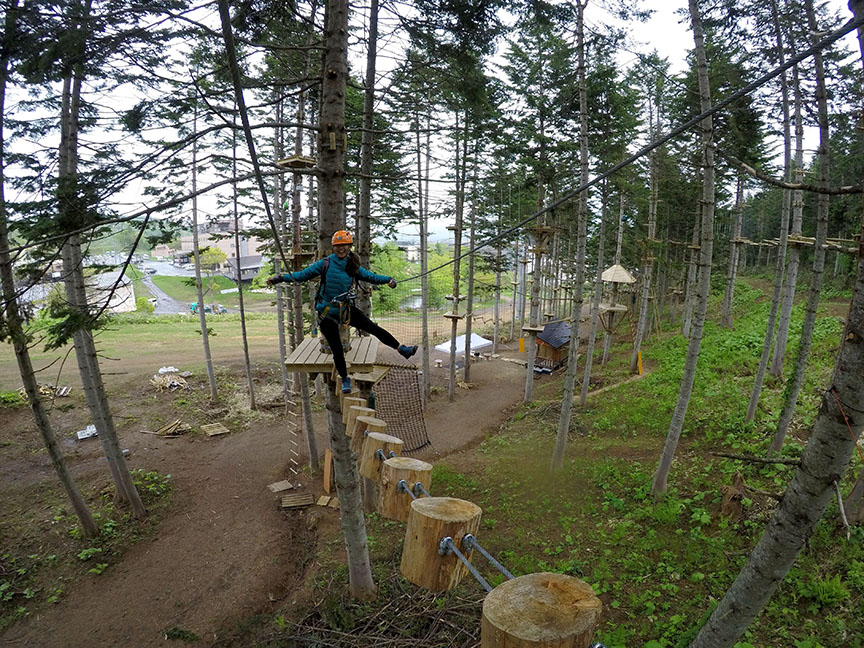
Although the obstacles are set between five to thirteen meters above ground, the park is very safe and monitored by professional instructors. Visitors have to be at least six years old and taller than 115 cm. for the standard courses and 140 cm. for advanced. The park is expanding to include a children’s and beginner-specific area where 16 obstacles will be built two to three meters off the ground.
When you visit, try Ross’ personal favorite: the red course, which features a trapeze bar/zipline you can only reach if you jump off a 13-meter-high ledge. If you manage to grab on to the trapeze bar, it’ll zipline you 70 meters through the forest.
Summer Paddling
While early May is peak whitewater season in Niseko with rapids reaching up to grade 3, the rivers quiet down to grades one or two heading into summer, which makes it a great time for family rafting and relaxing floats. Aside from building tree trek parks, NAC made its mark over two decades ago as Niseko’s first rafting company and continues to guide people down the great local rapids.
“During the economic recession in the early 90s, Niseko started to lose its customer base,” Ross recalls. “Pensions and hotels were concerned and wanted to do something in summer. So I bought one rafting boat and launched NAC—now we have 50 rafts . It turns out rafting was it.”
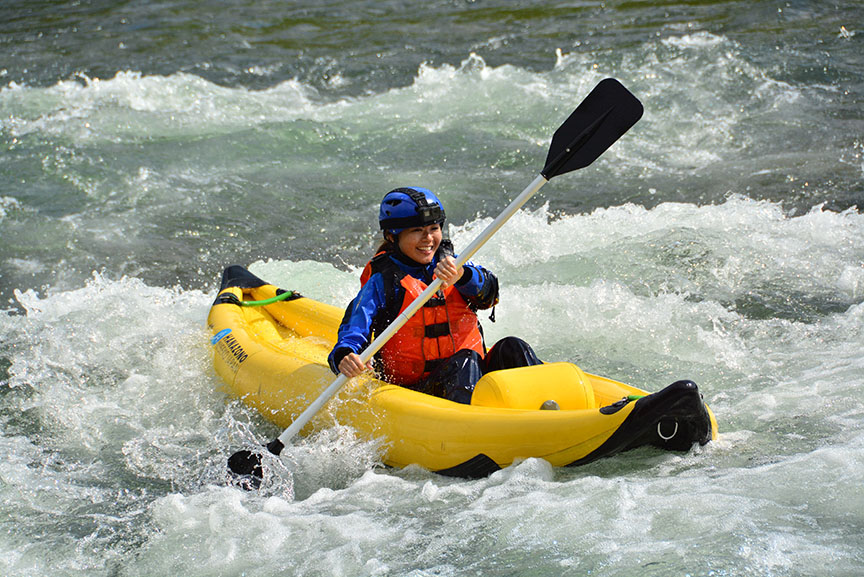
Depending on the day’s conditions, NAC’s trained guides will choose a course on the Shiribetsu River. The trip usually is about 12 kilometers long in spring and seven kilometers of whitewater action in summer including river jumps and swimming in calmer spots. While spring and early summer air may be warm, the water is still chilly so you’ll be given a drysuit.
If you are looking for more of a thrill try Hanazono Niseko’s guided ducky tours. A “ducky” is a cute term for a two-person inflatable raft you can also paddle solo. It’s easy to maneuver and you have the freedom to ride whatever waves you want to catch.
Duckies are closer to the water surface than a raft so you can feel the rapids more directly, but they also sit higher on the water compared to traditional kayaks and thereby are more stable and forgiving to most water conditions. They don’t capsize easily, but they’re still a fun work out especially if you’re paddling alone.
Niseko on Wheels
Niseko’s variety of flat and hilly terrain as made it a prime cycling destination, with numerous cycling races between June to September. Local passionate cyclists are also constantly building bigger and better mountain bike trails.
On the eastern edge of greater Hirafu Village is Ginto Trail, a community effort spearheaded by Ashley Nicholls of Holiday Niseko. This MTB trail was crowdfunded by the community and businesses.
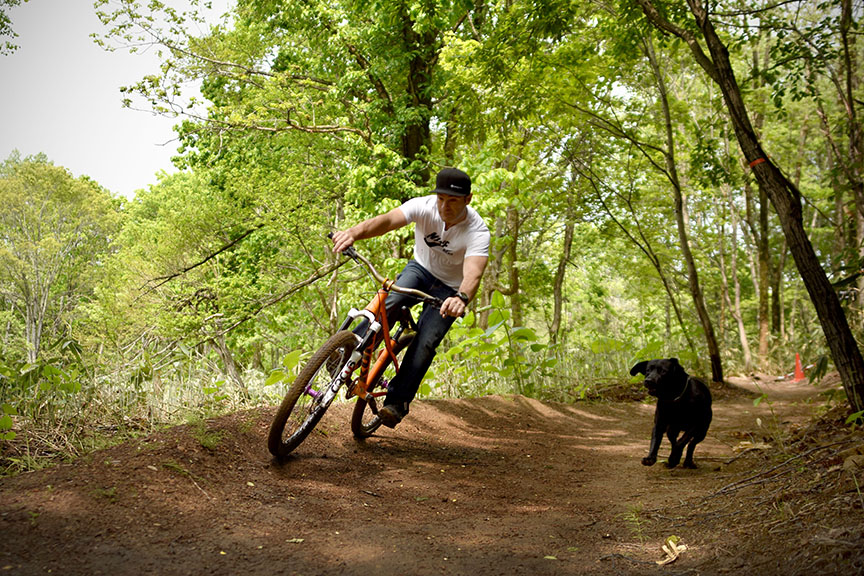
“Looking at all the major outdoor destinations around the world, I found mountain biking is the number one business in summer,” says Ashley, who usually goes for a few laps around Ginto Trail in the morning with his black lab Ryder. “It’s a healthy sport, it brings in mountain bikers from all around the world and it’s fun. We hope we can expand not just this trail, but more MTB trails around this region . Maybe even one looping around Mt . Yotei.”
Ginto Trail is an easily accessible 1.8-km. flow trail weaving through designated green zones around Pavilions hotel and residences, which are currently under construction. The trail is built on relatively flat terrain but features several bumps, jumps and banked turns which you can attack depending on your skill level. Best of all, it’s free to the public.
Just a few blocks away is Rhythm Japan. Starting off as a small ski rental shop, Rhythm grew to be a one-stop shop for cycling, hiking gear and SUP guided tours and rentals. During the winter, they’re Niseko’s biggest rental business for premium skis and snowboards.
“There’s already a lot of potential for Niseko, with increased investment in accommodation and infrastructure. The next obvious step is for green season to take over,” says Rhythm Japan owner Djan Aston. This year, Rhythm Japan is building a pump track using parts imported from the Czech Republic. The modular pump track will be set up at the local park for the community to use and also at Niseko’s summer festivals.
To combine cycling with travel, Rhythm Japan offers half-day and full-day tours to enjoy Niseko’s natural beauty and neighborhoods on wheels. Depending on your level, you can cycle a generally flat course stopping at mom-and- pop bakeries, Niseko Gelato and even an ostrich farm or challenge yourself to grueling hills with rewarding views of Mt . Yotei.
Rhythm Japan has its two-story headquarters at the base of Hirafu Zaka, the street leading up to Niseko Grand Hirafu. After a day outside, stop by for New Zealand Allpress coffee at Rhythm’s in-house café, Gloorious Coffee (that’s “Glorious” with two o’s) and say hi to their shop dog, Marlo the French bulldog.
As you explore Niseko town and talk to the residents, you’ll definitely run into a few people training for one of Niseko’s many cycling races. The biggest one is the Niseko Classic which will be held on July 7-8. Part of the international UCI Gran Fondo, the amateur cycling world tour, the Niseko Classic is one of only two Asian destinations on the tour and attracts more than 1,000 people from all over the world . The race features 70-km., 140-km. and, from this year, 3.4-km. time trial challenges . Amateur riders of all abilities are welcome. For a milder, non-competitive ride, the 64-km. Niseko Yotei Circuit Fun Ride will be held that same weekend .
The 9th annual Hanazono Hill Climb held Aug. 5 will give you a chance to explore the area as you cycle from Kutchan Community Hall to Goshiki Onsen. This bike race is 16 kilometers long and ends at the onsen 796 meters high on the northern base of Mt. Annupuri. Racers will have the chance to ride through the annual Kutchan Potato Festival as well.
Lake Toya
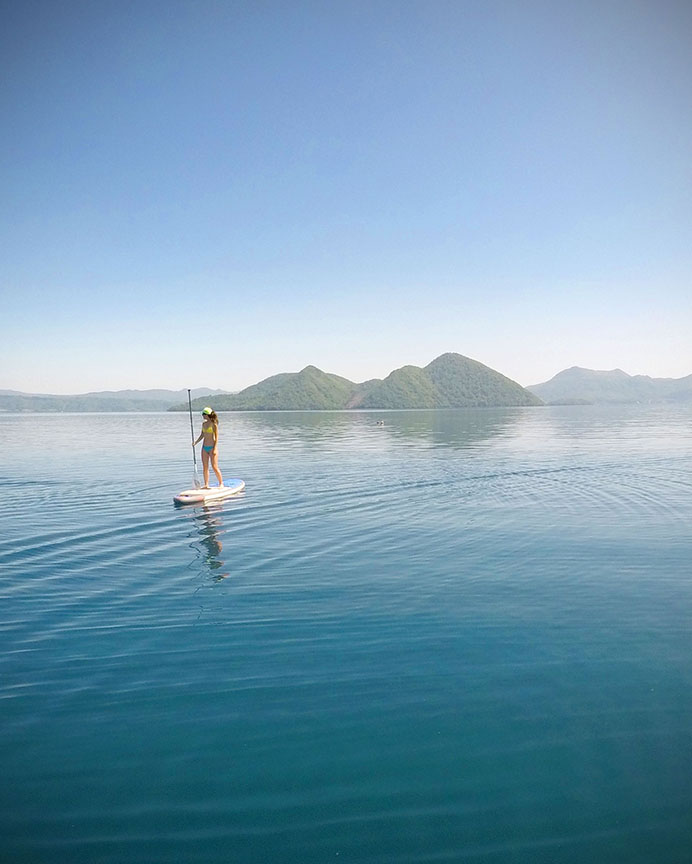
Part of the Shikotsu-Toya National Park, ake Toya is a freshwater caldera lake formed by an eruption from the still-active Mt. Usu and is the third largest of its kind in Japan. In mid-summer, the lake warms up making it the perfect swimming pool and campsite location.
Rhythm Japan operates SUP tours on this lake, going past Ukimido Park, which overlooks the lake with a small double tower monument built for Japanese Prince Shotoku . Perhaps most characteristic of the lake is its iconic Nakano Island. Daily ferries operate to this lake but you can also SUP there from the north shore (takes roughly two hours). “I grew up in Canada and I’ve always loved going to lakes,” says Black Diamond and Hokkaido Backcountry Club owner Clayton Kernaghan . “Many years ago, I bought a small boat and got her on Lake Toya. The first day on Toya…wow, it blew my mind . I’ve seen great lakes back home but the water here is so clean, clear and warm in July to September.” What started off as a hobby became part of Clayton’s business, and now he offers wakeboarding and wakesurfing tours in summer.
While Black Diamond and Hokkaido Backcountry Club has made its name as a world- famous extreme backcountry, heli and CAT skiing operation, they also run Black Diamond Lodge, year-round budget accommodation at the base of Niseko Village. Additionally, they rent out eight-passenger vehicles which can be converted into camping vans for adventurous travelers wanting to explore Hokkaido on their own.
“One of the unique things about Japan is each town has a michi no eki (roadside station). It has bathrooms, markets and big parking areas where you can park your van for free and even overnight,” says Clayton. “On weekends you see lots of camping vans parked at these stations: Japanese people exploring the country on their own with their family or friends. We want to offer foreigners this same experience.”
Blazing Trails
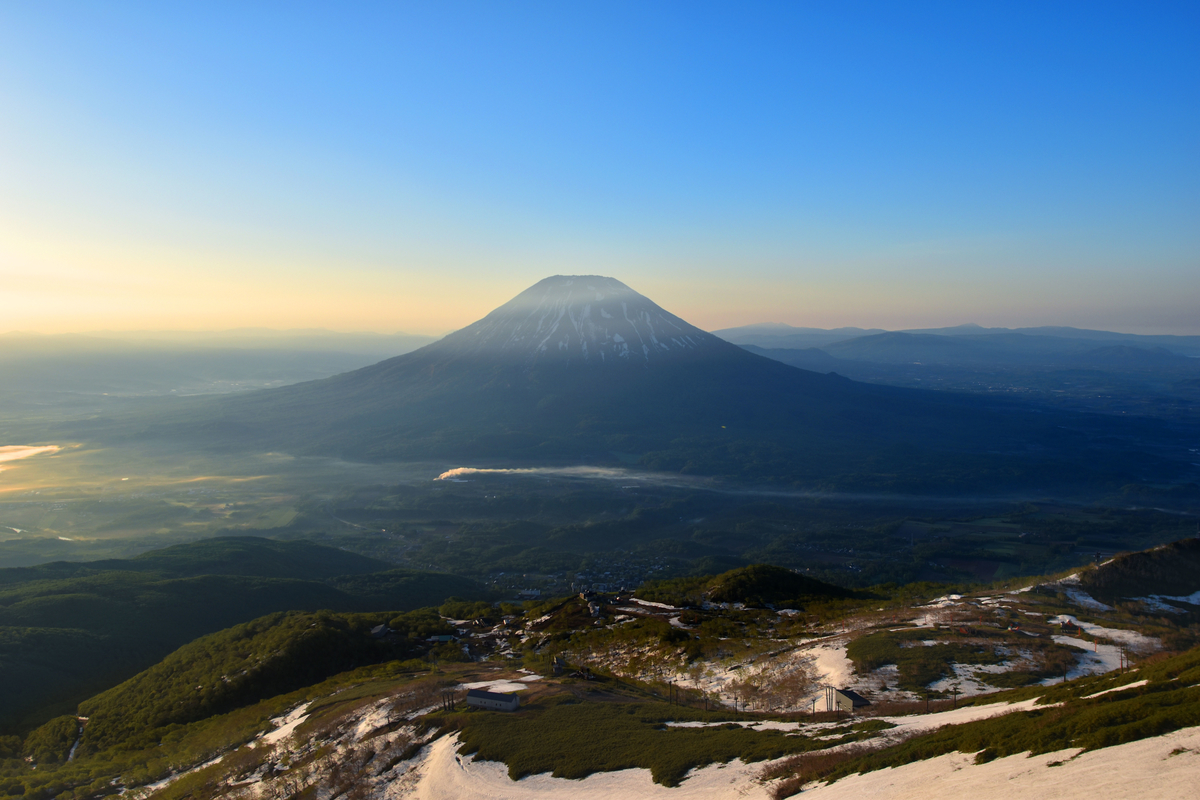
Mt. Annupuri (1,304 meters) is a quiet hiking spot in summer and an idyllic spot to catch the sunrise over Mt. Yotei (1,898 meters), a.k.a. “Ezo Fuji” for its resemblance to Mt. Fuji. Enjoy the striking 360-degree vistas from the top of Mt. Annupuri with Mt. Yotei to the south and the ridge trail leading to the Sea of Japan to the north. The easy hike takes roughly one hour from Goshiki Onsen to the summit. Don’t be surprised to find snow still covering many parts of the trail even in late spring.
The NAC Trail Run was Hokkaido’s first trail run. The 30-kilometer run tackles uphill mountain and forest trails, log hopping and creek crossings, and even summits Annupuri twice. A shorter 10-km. course and 5-km. forest trail course are also available. It will be held on Sept. 9.
As Niseko cools down in September, the 36th Niseko Marathon Festival, held on Sept. 16, is a refreshing run through Niseko’s hills. This event will host a 21-km. half marathon and 5-km. and 3.5-km. fun runs.
Local Art
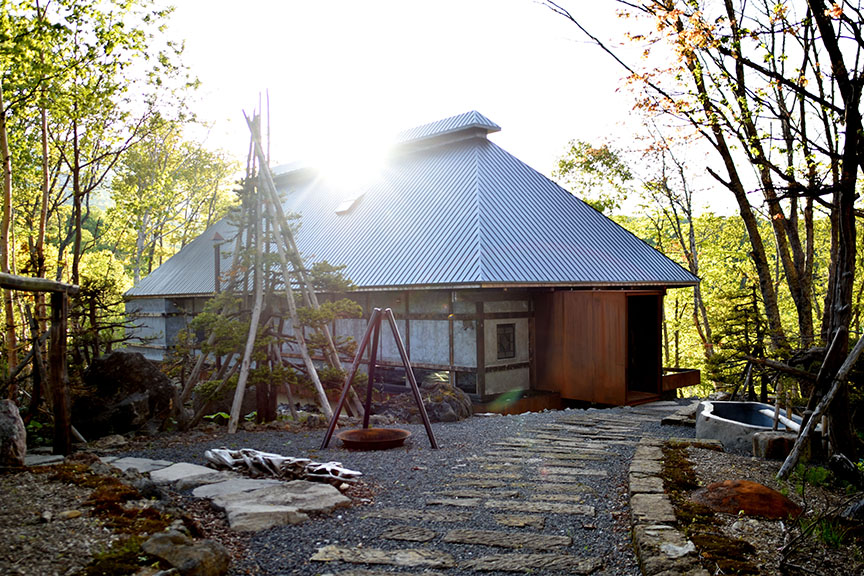
Niseko gives off an artistic vibe with many residents being talented craftsmen, entrepreneurs and designers. With few places in Hokkaido focused on supporting young artists, Hokkaido native Kiyoe Hosokawa opened Kiyoe Gallery on the second floor of Aya Niseko Hotel. Kiyoe Gallery displays a stunning variety of ceramics, paintings, sculptures and installation art, mainly by Hokkaido artists.
“Niseko is such an international location,” says Kiyoe. “I want to introduce our international visitors to the local art scene and Hokkaido culture, and have something they can look forward to when they’re here in summer.”
Kiyoe Gallery will be hosting its second Aya Niseko Summer Art Festival from Aug. 3-13. This year, the festival will be themed “Nature” and feature artists including Kineta Kunimatsu. Aside from the festival, the gallery regularly holds artist workshops and koto concerts.
Somoza is a feast for the eyes . More gallery than restaurant, this Japanese-style cultural space designed by Shouya Grigg is a fusion of Japanese art, Ainu and northern Japanese culture and international elements. Built by elements from a 150-year-old farmhouse, Somoza sits on a cliff in the Hanazono area and guests are treated to a panoramic view of the valley and river below.
“I came to Japan 25 years ago and went straight to Hokkaido,” Shouya remembers arriving with his bicycle and panniers. While studying film and photography back in Australia, Shouya learned about Japanese cinema and was awestruck by nature photographs taken in Hokkaido. “I knew I had to go there. I arrived in Hokkaido, didn’t know anybody, didn’t speak Japanese…so I just cycled.”
While Shouya never felt at home in Western Australia, he immediately felt comfortable during his four-month cycle around Hokkaido, which reminded him of his original home in Yorkshire, U.K. Today Shouya’s work reflects his first love for Hokkaido especially through his painting-like photographs printed on washi paper and architectural designs at Somoza, where every nook and cranny is built with intention. Somoza is a three-story building with tearooms on the top floor, the main dining area on the first floor and Shouya’s studio downstairs. During the day, the venue serves lunch and tea and at night it is a fine dining establishment. Guests are given a tour of Somoza and its art collection.
“I found designing Somoza similar to making a film, because I wanted to tell a story,” says Shouya . “First, you find a location, build a set— the building—then create the atmosphere using lighting and furniture . Then you have the crew, the staff, who helps you make the film happen. The cast is made up of guests who dine here. It’s a living film.”
Accommodation
While the green season is quieter than winter, it’s still best to book ahead as hotels can get fully booked with international group tours or school groups. The more convenient parts of town to stay are near Niseko Village or Hirafu resorts . Closer to Niseko Station, Niseko Village is made up of three hotels: Kasara townhouses, the Hilton and Green Leaf. The Hilton and Green Leaf are convenient if you want to soak in a hot spring, as they both have in-house onsen baths . You can also go for a swim in Green Leaf’s year-round thermal pool.
For bigger groups, Vacation Niseko manages luxury apartments, houses, townhouses and budget-friendly apartments in the heart of Hirafu. MUSE Niseko is a sleek, minimalist accommodation looking out towards Mt. Yotei. The more casual Kizuna a few blocks away is on Hirafu Zaka slope and close to NAC Adventure Park and Hirafutei if you want to have a drink at Toshiro’s Bar or take a dip in the hotel’s onsen.
Getting There
If you’re flying into Hokkaido, chances are you’ll be arriving at New Chitose Aiport, Hokkaido’s biggest airport. The best way to get to Niseko during the green season is to take the JR Rapid Airport line from the airport, change trains at Otaru Station and take the JR Hakodate Line to either Niseko or Kutchan Station. Most accommodation offers shuttle pick-up services from these stations.
Summer Events
Aug. 4: Niseko Town Tanabata Fireworks Festival
Aug. 4: Kutchan Jaga Matsuri (Potato Festival)
Aug. 18: Hirafu Festival
Aug. 25: Niko Niko Niseko Village Festival
September 13: 2018 Niseko Autumn Food Festival
For more information on activities, accommodation and events, check out Niseko Tourism or download their official app, “Niseko.”
